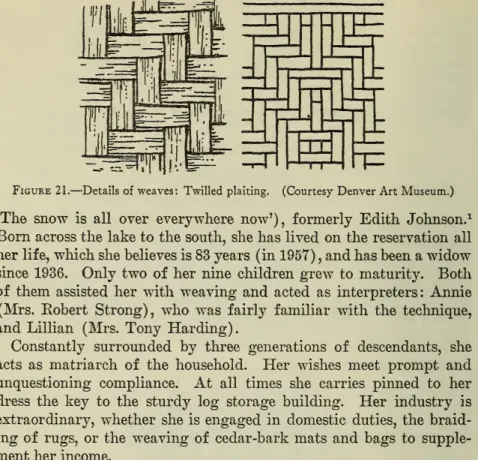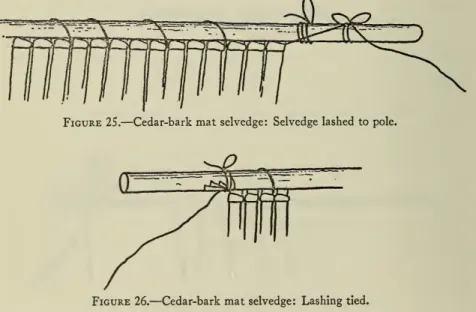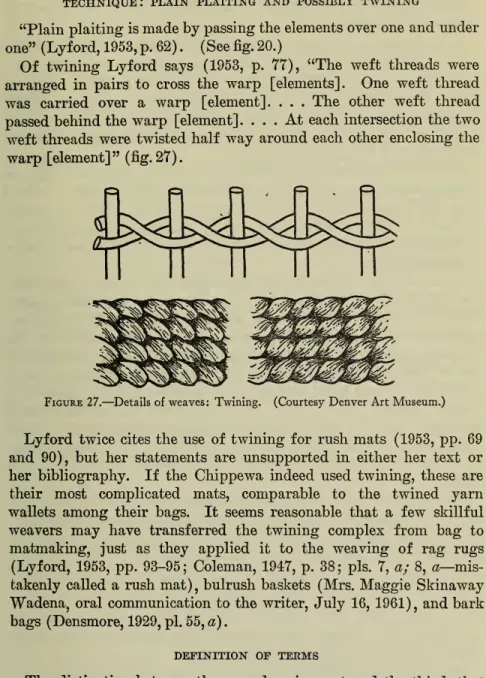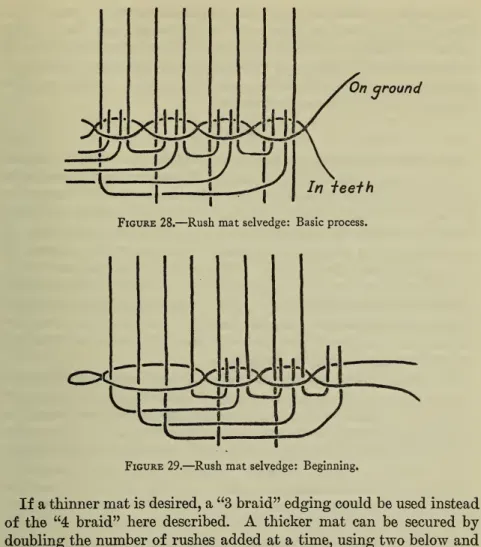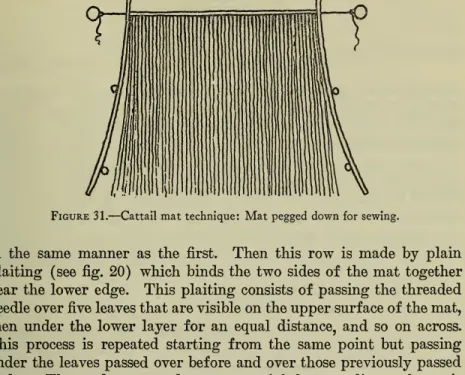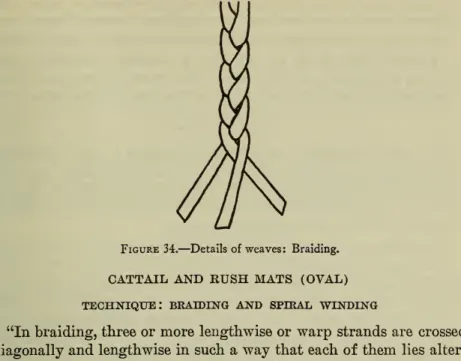The community of Nett Lake, in the reservation of the same name a little south of International Falls, has preserved this ingenious craft because of its remoteness. The writer has found no recollection of the former production of cedar bark in any other area of Minnesota except the GrandPortage Eeservation, in the northeastern end of the state.
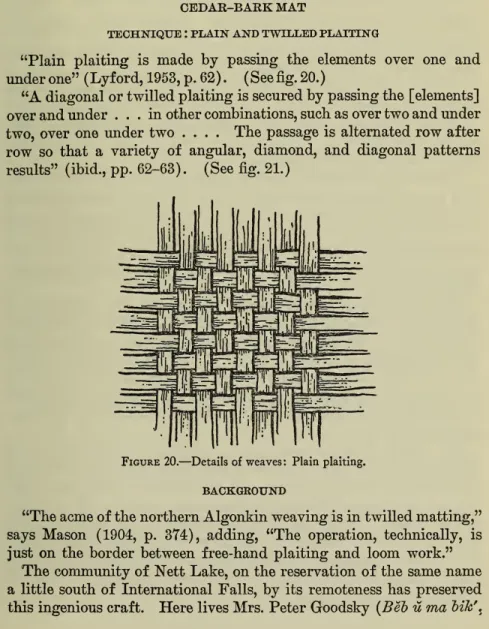
GATHERING MATERIALS
After the outer bark was removed, "the remaining, more flexible, part of the bark was further divided... so that the rougher, dark brown, outer layers were detached from the softer, lighter-colored inner layers." Instead, Mrs. Goodsky, as hereafter described, scraped off this coarse bark with a knife and split .. t^l^ap.Pap. CHIPPEWA MAT WEAVING TECHNIQUES — PETERSEN 223 . the remaining strip in two thicknesses. When the strips are finished, and the electric dye is ready, a mass of the shorter strips is loosened, wound up loosely, inserted into you {udis' si . gun), and stirred with a stick until completely wet.
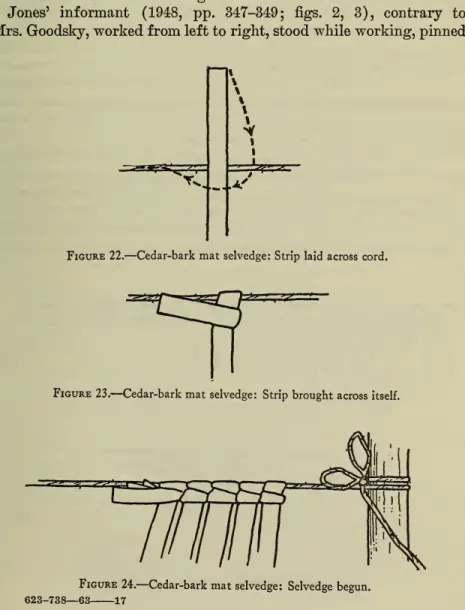
WEAVING
34;6 feet 5 inches long and 4 feet 5 inches wide," which was made "in a single day, the work beginning at 9 o'clock in the morning, and the finished product being delivered 2 miles distant at 4 o'clock in the afternoon. " In 1956, another informant, Ms. Additional information on these rugs can be found in the next section under "Frustra Predominance over Cedarwood Rugs".
RUSH MAT (RECTANGULAR)
While the mentioned general reference sources do not show a uniform-. in the sense of "sleep" it usually refers to the United States of some species of Scirpios, a leafless plant often found standing like a whip in the shallow water of a lake. Cattail or birch bark mats used for sidewalls overlap horizontally like modern siding, while birchbark roof mats overlap over the top edge of the sidewalls and over each other like shingles.
BACKGROUND
With his right hand he grasps the 4-inch end of the tallest of the two last-added rushes, bends the end to the right and away from him so that it lies between the cords, and holds with his left thumb and forefinger. He repeats the twisting of the rope and the other four steps until he reaches the length of the carpet.
CHIPPEWA MAT-WEAVING TECHNIQUES — ^PETERSEN 243
It is nailed to two trees at the weaver's eye level and is raised during weaving when the work becomes inconveniently low. Tension on the theme is achieved by tying to each of these stakes at a third of the way from the top edge of the wi'goob twice the width of the theme lengthwise and doubled in the middle where it is attached to the end of the green string in the first row. To the left are attached the weft threads, two of which are made by doubling in the center a piece of wi'gobh yarn twice the length of the mat and looping it around the left edge.
It adjusts the height of the work "by providing an arrangement to stand down under the cross piece down the back of the supports and by having another top cross piece over which the mat can hang." With the other half of the double yarn, the process is repeated, except this time the reeds from the back are raised. Men did not help anywhere else in the process except to gather and work materials, perhaps because they were busy elsewhere on the actual weaving day.
Mulches do not vary much in width, as this dimension must correspond to the length of the rushes. Decoration and design can be introduced into mats by dyeing some mats, by changing the weaving technique, or by a combination of these two methods.
USE OF MATS
34;A diagonal plaid was woven by carrying one half of the piping diagonally to the left and the other half to the right, says Lyford (1953, p. 90). The following designs appear to be those used in the mats depicted: bands of geometric designs (Boyle ,1898,fig.. 1, &); intricately framed geometric design and bands. Although little used today [1953], the rush mats are still made with straight lines and diagonal designs elaborated in colored piping.
One hundred years ago, Eastman Johnson, a visitor to Grand Portage, Minn., painted the only known pictorial record of a Chippewa rush mat used in this. The interior of their [Mide] lodge or shrine was hung round with mats constructed of reeds, to which were attached various offerings, consisting chiefly of scraps of red and blue cloth, calico, &c., strings of pearls, scalps of enemies. These mats, with which the Ojibbeways cover the walls of their wigwams, and which also serve as blankets, beds, and couches, are the handiwork of the women, and are excellently made.
PEEDOMINANCE OF RUSH OVER CEDAR-BARK MATS
No study using commercial cord lasted 33 hours; before that in Volney Jones's article, in which the worker made her own rope.
CATTAIL MAT (RECTANGULAR)
TECHNIQUE : PIERCED WARP WITH TWO ROWS OF PLAIN PLAITING Pierced warp is defined as "the form of weaving in cat-tail and other
The lower ends of the sheets are placed evenly together, and the excess above 55 inches is cut off the upper ends by laying the bundle on the ground and cutting it with a knife (pi. The size and number of mulches were determined by the size of the lodge and the proportion of the corresponding area carpeted therefore, the lower ends of the inner sheets and the upper ends of the outer sheets are used to make this edge.
The treated bundles are opened and laid on the left side of the worker with the ball of double tying cord on her right. She places the leaves behind the foundation rope with about 1^ inches sticking out on the right side of the rope. The additional width of the mat at the bottom edge matches the shape of the wigwam.
Then this line is made with simple knitting (see fig. 20) that connects the two sides of the rug near the bottom edge. They are warm, cozy and more comfortable than birch bark covers or birch bark tents.
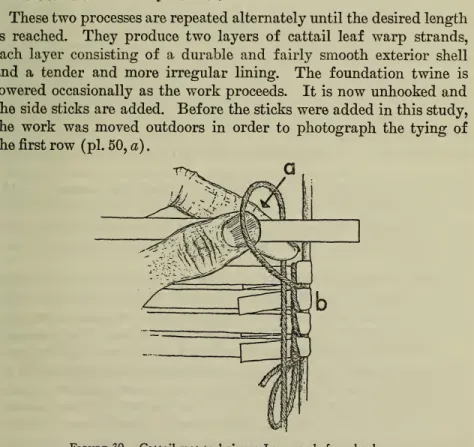
CHIPPEWA MAT-WEAVING TECHNIQUES — ^PETERSEN 263
USB OF MATS
CHECKLIST FOR DISTINGUISHING RUSH AND CATTAIL MATS
MINOE MATS
REED MAT^
However, by using knots, the technique moves away from the general concept of weaving, in which elements simply intersect, and into the realm of networks, in which intersecting elements are knotted.
MANUFACTURE
The product of this technique may not differ from that of interlaced weaving, except for the twisting (instead of knotting) of the weft elements in the latter, which alternately brings one element to the front and back of the warp elements. The sources used for this study lack any representation of the knotted weft technique. The rest of the work is merely a repetition of the addition of reeds and.
The knot used in weaving is a half hook, in which the free end, pointing to the left, is crossed over the inactive thread on the side facing the worker, doubled behind the thread so that it points to the right, and to the worker is drawn. through the loop formed by the active thread until the knot is fairly tight. At the end, the mat is laid on a blanket, the grass is plucked and the berries fall on the blanket. A presumably Chippewa rug similar to this one was collected in July 1956 by John Macfie of Parry Sound, Ontario, Canada, in an abandoned cranberry picking camp near Pickle Lake, Ontario, about 115 miles northwest of Lake Nipigon (pi. 60, 5) / Crafts of the Cree, 1957, p. 57).
The reeds are tied parallel to each other with 7 rows of laces, each consisting of 2 strands of stirrup work. This condition, together with a tighter half-hook knot that brought the reeds closer together, provided a surface that, over most of its area, would not require grass to keep the berries on top of theme.
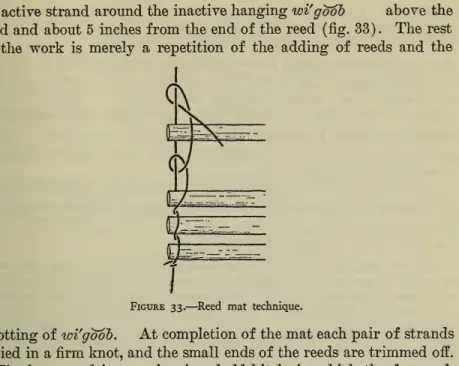
CHIPPEWA MAT-WEAVING TECHNIQUES — ^PETERSEN 269
CATTAIL AND RUSH MATS (OVAL) technique: braiding and spiral WINDING
John Benaise (Little Partridge), whose Indian name is tJm toy ashf i, *The wind blows up.' She was born in Manitoba and in 1957 lived on the southwest coast of. They are plaited in the same way as ragrugs, except that each of the three strands consists of three to five leaves. Blindstitching is used to hide the thread; that is, the thread is passed through the loop formed by the bend in an outer warp strand and passes through alternating loops of adjacent braid helices.
No. 67] CHIPPEWA MAT WEAVE TECHNIQUES — PETERSEN 271 and formerly of Gull Lakenorthof Brainerd, says that they should be killed with hot water "so that they do not break so easily and become stiff."
SWEETGRASS MAT
34;However, no wide chasm separates the different varieties of textiles, beginning with such coarse products as cloth fences and fish weirs and ending with the fine lace and needlework." Wisconsin, and the Leech Lake, Minnesota, area The present study found that all the sweetgrass workers are women, and Jones agrees with but one exception.
The scientific name of "Indian perfume" was found in this study to be Hierochloe odorata (L.) Wahlenb. The leaves are collected by grasping the shoots firmly near the ground and pulling them steadily until they are detached from the rootstocks, which are in two parts below the surface. Bigbear emphasized "cleaning up" the grass (that is, discarding the short parts and the reddish bottom) as essential for a beauty, while Mrs. Pemberton used colored edges trimmed from the heavy.
Bigbear then tied the bundles together in pairs and hung them on the line in the house to dry for about 2 days. This restores firmness and brings out the aroma." However, the stove-dried product after 2 years had retained enough color, odor and firmness to be used without getting wet.
MAKING THE MAT
CHIPPEWA MEASUREMENT WEAVING TECHNIQUES —^PETERSEN 275 Shortly before a blade of grass runs out, another strand is added. to bring it up to the original thickness. To do this, the last stitch is doubled and the thread is wound around the long end of the bobbin % of an inch to 1 inch, with the thread spaced at the same intervals that will be used between the below, which is added when. The grass is carefully bent at a right angle to the mat, the wrapping is continued for an equal length. and the thread is joined with a double stitch to the mat at a point where a row of stitches joins.
Successive rows are similar to those in the central part. When the desired size is reached, work continues until the blade of grass is finished. 34;When they become three-eighths of an inch apart," he says, "a stitch is made midway between the two preceding circles, and thus begins a new radius.". The grass is sewn to the bark with stitches through both layers and about one-fourth of an inch. from the edge.
Warping of the bark is minimized by running the grain of the two layers in opposite directions, and sometimes a piece of cardboard is placed between them as an extra precaution. The design is drawn on the wrong side of the bark, and on the right side holes are made with an awl, from which both ends of the spines are inserted, sometimes flattened and sometimes not.
MATS OF UNKNOWN TECHNIQUES
SUMMARY
They were then split while still soft, dried in the sun, rubbed between the hands and pleated [braided or woven?]. These mats, now produced for sale, were formerly used as ground covers, partitions or doors, in drying food and smoking meat, or sometimes as linings for the walls of wigwams. Rushes are pulled in midsummer, cut to the desired width for the mat, boiled and bleached in the sun.
When the Typha latifolia L., or cattail, matures in the fall, the leaves are cut, separated, bundled, trimmed and dried. The time required for the small mat in this study would probably be approximately 20 hours under normal conditions. The cattail mat was remarkably adapted to its use as an exterior covering for a lodge.
The reeds are cut, stripped, trimmed and tied side by side with a double wi'gobl) cloth knotted between every two reeds. No*67T*"^^^' CHIPPEWA MEASUREMENT CONSTRUCTION TECHNIQUES —^PETERSEN 281 appropriate; it accompanied the Chippewa literally from cradle to grave.
LITERATUEE CITED
BUREAU OF AMERICAN ETHNOLOGY BULLETIN 186PLATE46. a, Complete cedar-barkmaton frame, b, Mattress materials: unstained and painted strips of cedar bark, prepared and unsplit tail leaves, treated bush, deer rib needles, and wood needles for tail cats .
